Social Networks, Engagement and Resilience in University Students
Abstract
:1. Introduction
- -
- To quantify the degree of resilience and engagement (absorption, dedication and vigour) of a group of university students according to the academic year that they belong to.
- -
- To graphically represent the sociocentric networks of contact of the three academic years.
- -
- To identify what level of similarity students have when selecting the places where they share information.
- -
- To analyse the relationship between the centrality structural variables of the class’s network of contacts and students’ engagement and students’ resilience.
2. Materials and Methods
2.1. Sample Description
2.2. Variables
- -
- Composition variables. Sex and course year were the attributes selected for the present study.
- -
- Engagement and its three dimensions of absorption, dedication and vigour.
- -
- Resilience.
- -
- Centrality structural variables: degree, indegree, outdegree, closeness, eigenvector, and betweenness of each of the participants. By calculating the outdegree, it is possible to represent the links that go from the node to the components of his or her class. Computing the indegree reveals relationships that go from other participants toward the node. We also considered it appropriate to determine degree, which takes both situations into account. In addition, we decided to stipulate the centrality of proximity (closeness), the centrality of intermediation (betweenness) and the degree of influence of each actor (eigenvector) [33].
2.3. Data Collection Instruments
- -
- Students’ sex and course year.
- -
- -
- The Connor-Davidson resilience scale, specifically the abridged version by Campbell-Sills and Stein [35], which has been validated for young Spaniards by Notario et al. [36] in 2011: the CD-RISC 10. This instrument, with 10 items, evaluates the level of agreement or disagreement in relation to each of them with a range that goes from 0 to 4.
- -
- Variables for the structure of the students’ network of contacts. To calculate the centrality of Type 1 Networks (Support and Friendship Networks), we used a limited actor census and a 0 to 4 Likert scale with two items (item 1: to whom you ask for help and item 2: who is your friend), to determine the intensity of the relationship. For Type 2 Networks (where to share information), we offered a list of places (class, library, campus corridors, campus cafe, other cafes, gym, email, and WhatsApp), as well as the possibility of adding options where the respondents felt it appropriate to do so. A Likert scale (from 0 to 4) and two items (item 1: where the academic information is shared and item 2: where they share personal information) were used to measure frequency.
2.4. Procedure
2.5. Data Analysis
2.6. Ethical Considerations
3. Results
4. Discussion
5. Conclusions
Acknowledgments
Author Contributions
Conflicts of Interest
References
- Thomas, L.J.; Revell, S.H. Resilience in nursing students: An integrative review. Nurse Educ. Today 2016, 36, 457–462. [Google Scholar] [CrossRef] [PubMed]
- Martínez, I.; Salanova, M. Niveles de burnout y engagement en estudiantes universitarios: Relación con el desempeño y desarrollo profesional. Rev. Educ. 2003, 330, 361–384. [Google Scholar]
- Turner, M.; Holdsworth, S.; Scott-Young, C. Resilience at university: The development and testing of a new measure. High. Educ. Res. Dev. 2017, 36, 386–400. [Google Scholar] [CrossRef]
- Gulbay, E.; La Marca, A.; Schiavone, S. The creativity and resilience development Project (CRDP) to investigate learning practice in the use of ICT. In Proceedings of the EDULEARN16 Proceedings, Barcelona, Spain, 4–6 July 2016; pp. 3139–3145. [Google Scholar]
- Schaufeli, W.; Salanova, M.; González, V.; Bakker, A. The measurement of engagement and burnout: A two sample confirmatory factor analytic approach. J. Happiness Stud. 2002, 3, 71–92. [Google Scholar] [CrossRef]
- Salanova, M.; Llorens, S.; Cifre, E.; Martínez, I.; Schaufeli, W.B. Perceived collective efficacy subjective well-being and task performance among electronic work groups: An experimental study. Small Group Res. 2003, 34, 43–73. [Google Scholar] [CrossRef]
- Linnenbrink, E.A. Emotion research in education: Theoretical and methodological perspective on the integration of affect, motivation and cognition. Educ. Psychol. Rev. 2006, 18, 307–314. [Google Scholar] [CrossRef]
- Viviana, G.; Noemi, L. Association of academic events and coping strategies with the presence of burnout engagement in medical student. Acta Psiquiatr. Psicol. Am. Lat. 2017, 63, 6–19. [Google Scholar]
- Liébana-Presa, C.; Fernández-Martínez, M.E.; Gándala, A.; Muñoz-Villanueva, M.C.; Vázquez-Casares, A.M.; Rodríguez-Borrego, M.A. Psychological distress in health sciences college students and its relationship with academic engagement. Rev. Esc. Enferm. USP 2014, 48, 715–722. [Google Scholar] [CrossRef] [PubMed]
- Gómez, P.; Pérez, C.; Parra, P.; Ortiz, L.; Matus, O.; McColl, P.; Torres, G.; Meyer, A. Academic achievement, engagement and burnout among first year medical students. Rev. Med. Chile 2015, 143, 930–937. [Google Scholar] [CrossRef]
- Menezes, V.; Fernández, B.; Hernández, L.; Ramos, F.; Contador, I. Resiliencia y el modelo burnout-engagement en cuidadores formales de ancianos. Psicothema 2016, 18, 791–796. [Google Scholar]
- Wonodi, C.; Privor, L.; Aina, M.; Pate, M.; Reis, R.; Gadhoke, P.; Levine, O. Using social network analysis to examine the decision-making process on new vaccine introduction in Nigeria. Health Policy Plan. 2012, 27 (Suppl. S2), 27–38. [Google Scholar] [CrossRef] [PubMed]
- Sánchez, A.; Vázquez, N.; Velasco, A.; Soria, V. Researching Resilience: The need for networked methods. In The Second World Congress on Resilience: From Person to Society, Timisoara, Romania; Monduzzi Editore: Milan, Italy, 2014; ISBN 978-88-7587-697-5. [Google Scholar]
- You, J.W. The relationship among college students psychological capital, learning empowerment, and engagement. Learn. Individ. Differ. 2016, 49, 17–24. [Google Scholar] [CrossRef]
- Luthans, K.; Luthans, B.; Palmer, N.F. A positive approach to management education the relationship between academin PsyCap and student engagement. J. Manag. Dev. 2016, 35, 1098–1118. [Google Scholar] [CrossRef]
- Epstein, R.; Krasner, M.S. Physician resilience: Why it matters, and how to promote it. Acad. Med. 2013, 88, 301–303. [Google Scholar] [CrossRef] [PubMed]
- Greene, R.R.; Conrad, A.P.; Livingstone, N.C.; Barton, W.H.; Watkins, M.L.; Blundo, R.; Riley, J.G. An Integrated Approach to Practice, Policy, and Research; NASW Press: Washington, DC, USA, 2002. [Google Scholar]
- Bronfenbrenner, U. The Ecology of Human Development: Experiments by Nature and Design; Harvard University Press: Cambridge, MA, USA, 1979. [Google Scholar]
- Masten, A.S.; Coatsworth, J.D. The development of competence in favorable and unfavorable environments: Lessons from research on successful children. Am. Psychol. 1998, 53, 205–220. [Google Scholar] [CrossRef] [PubMed]
- Janssen, M.A.; Bodin, O.; Anderies, J.M.; Elmqvist, T.; Ernstson, H.; McAllister, R.R.J.; Olsson, P.; Ryan, P. A network perspective on the resilience of social-ecological systems. Ecol. Soc. 2006, 11, 15. [Google Scholar] [CrossRef]
- Rodríguez, A.; Ramos, E.; Ros, I.; Fernández, A.; Revuelta, R. Resilience and school engagement by gender and education level in secondary education. AULA ABIERTA 2016, 44, 77–82. [Google Scholar] [CrossRef]
- Ungar, M.; Liebenberg, L. Ethnocultural factors, resilience and school engagement. Sch. Psychol. Int. 2013, 34, 514–526. [Google Scholar] [CrossRef]
- Wasserman, S.; Faust, K. El análisis de redes sociales en las ciencias sociales y del comportamiento. In Análisis de Redes Sociales. Métodos y Aplicaciones, 1st ed.; Wasserman, S., Faust, K., Eds.; Centro de Investigaciones Sociológicas: Madrid, Spain, 2013; pp. 35–58. ISBN 9788474766318. [Google Scholar]
- Borgatti, S.P.; Mehra, A.; Brass, D.J.; Labianca, G. Network analysis in the social sciences. Science 2009, 323, 892–895. [Google Scholar] [CrossRef] [PubMed]
- Paniagua, J.A. (Ed.) Introducción. En Curso de Análisis de Redes Sociales. Metodología y Estudios de Caso; Universidad de Granada: Granada, Spain, 2013; pp. 15–27. ISBN 9788433854735. [Google Scholar]
- Del Fresno, M.; Marqués, P.; Paunero, D.S. Conectados por Redes Sociales: Introducción al Análisis de Redes Sociales y Casos Prácticos, 1st ed.; Editorial UOC: Barcelona, Spain, 2014; ISBN 978-84-9064-234-4. [Google Scholar]
- Durling, R.; Schick, C. Concept attainment by pairs and individuals as a function of vocalization. J. Educ. Psychol. 1976, 68, 83–91. [Google Scholar] [CrossRef]
- Bruun, J.; Brewe, E. Talking and learning physics: Predicting future grades from network measures and force concept inventory pretest scores. Phys. Rev. Spec. Top.-Phys. Educ. Res. 2013, 9. [Google Scholar] [CrossRef]
- Huiyoung, S.; Allison, R. Early adolescent friendships and academic adjustment: Examining selection and influence processes with longitudinal Social Network Analysis. Dev. Psychol. 2014, 50, 2462–2472. [Google Scholar] [CrossRef]
- Marqués, P.; Alfonso, J.; Fernández, E.; Pinto, A.; Liébana, C.; Conde, M.A.; García, F.J. Cooperative networks and their influence on engagement: A study with students of a degree in nursing. J. Med. Syst. 2017, 41, 103. [Google Scholar] [CrossRef] [PubMed]
- Barraza, A.; Ceceñas, P. La red de apoyo social y su relación con el síndrome de burnout en alumnos de licenciatura. Diálogos Pedagóg. 2016, 14, 90–106. [Google Scholar]
- Stephens, T. Nursing student resilience: A concept clarification. Nurs. Forum 2013, 48, 125–133. [Google Scholar] [CrossRef] [PubMed]
- Freeman, L. Centrality in social networks: Conceptual clarification. Soc. Netw. 1979, 1, 215–239. [Google Scholar] [CrossRef]
- García, J.; Labajos, M.; Fernández, F. Engagement and academics results of the grade students. Rev. Rol. Enferm. 2013, 36, 570–577. [Google Scholar]
- Crespo, M.; Fernández, V.; Soberón, C. Adaptación española de la “escala de resiliencia de Connor-Davidson” (CD-RISC) en situaciones de estrés crónico. Psicol. Conduct. 2014, 22, 219–238. [Google Scholar]
- Notario, B.; Solera, M.; Serrano, M.; Bartolomé, R.; García, J.; Martinez, V. Reliability and validity of the Spanish version of the 10-item Connor-Davidson Resilience Scale (10-item CD-RISC) in young adults. Health Qual. Life Outcomes 2011, 9, 1–6. [Google Scholar] [CrossRef]
- Marqués, P. Influencia de las Redes Sociales en el Rendimiento de las Organizaciones: Un Estudio en el Sector Sanitario. Ph.D. Thesis, Universidad de León, León, Spain, 2009. [Google Scholar]
- Arias, N. Las Administraciones Públicas como Soporte en la Prevención Contra la Obesidad Juvenil: Estudio de Factores Relacionales y Análisis de Redes Sociales. Ph.D. Thesis, Universidad de Salamanca, Salamanca, Spain, 2016. [Google Scholar]
- Borgatti, S.P.; Everett, M.G.; Freeman, L.C. Ucinet for Windows: Software for Social Network Analysis; Analytic Technologies: Harvard, MA, USA, 2002. [Google Scholar]
- Hachul, S.; Jünger, M. An experimental comparison of fast algorithms for drawing general large graphs. In Graph Drawing; Healy, P., Nikolov, N., Eds.; Springer: Berlin/Heidelberg, Germany, 2005; Volume 3843, pp. 235–250. [Google Scholar]
- Liébana, C. Salud Emocional en Estudiantes Universitarios de Enfermería y Fisioterapia de Castilla y León. Ph.D. Thesis, Universidad de Córdoba, Córdoba, Spain, 2012. [Google Scholar]
- Rios, M.I.; Carrillo, C.; Sabuco, E.; García, M.; Martínez, M.E. An exploratory study of the relationship between resilience, academic burnout and psychological health in nursing students. Contemp. Nurse 2016, 52, 430–439. [Google Scholar] [CrossRef] [PubMed]
- Tomas, J.; Nicolau, D.; Expósito, M. The social relations of university students: Intensity, interaction and association with academic performance. Cult. Educ. 2016, 28, 667–701. [Google Scholar] [CrossRef]
- Grunspan, D.; Wiggins, B.; Goodreau, S. Understanding classrooms through social network analysis: A primer for social network analysis in education research. CBE Life Sci. Educ. 2014, 13, 167–178. [Google Scholar] [CrossRef] [PubMed]
- Paredes, A.; Vitaliti, J.M.; Aguirre, J.; Strafile, S.; Jara, C. Tipos de apoyo y la digitalización de las redes personales: El uso de Facebook de adolescentes rururbanos de Mendoza (Argentina). Redes Rev. Hisp. Para Anál. Redes Soc. 2015, 26, 97–123. [Google Scholar] [CrossRef]
- Chang, S.M.; Lin, Y.H.; Lin, C.W.; Chang, H.K.; Chong, P.P. Promoting positive psychology using social networking sites: A study of new college entrants on facebook. Int. J. Environ. Res. Public Health 2014, 11, 4652–4663. [Google Scholar] [CrossRef] [PubMed]
- Rubio, J.; Perlado, M. El fenómeno WhatsApp en el contexto de la comunicación personal: Una aproximación a través de los jóvenes universitarios. Rev. Icono 14 2015, 13, 73–94. [Google Scholar] [CrossRef]
- López, A.I.; López, M.; Fernández, M.E.; Liébana, C.; Gutiérrez, L. Approaches to learning, engagement, leisure and past performance. Bordon 2016, 68, 67–88. [Google Scholar] [CrossRef]
- Froneman, K.; du Plessis, E.; Koen, M.P. Effective educator-student relationships in nursing education to strengthen nursing students’ resilience. Curationis 2016, 39, 1–9. [Google Scholar] [CrossRef] [PubMed]
- Zhao, F.; Guo, Y.; Suhonen, R.; Leino, H. Subjective well-being and its association with peer caring and resilience among nursing vs. medical students: A questionnaire study. Nurse Educ. Today 2016, 37, 108–113. [Google Scholar] [CrossRef] [PubMed]
- Friemel, T.N. Why Context Matters: Applications of Social Network Analysis; Springer: Berlin, Germany, 2008. [Google Scholar]
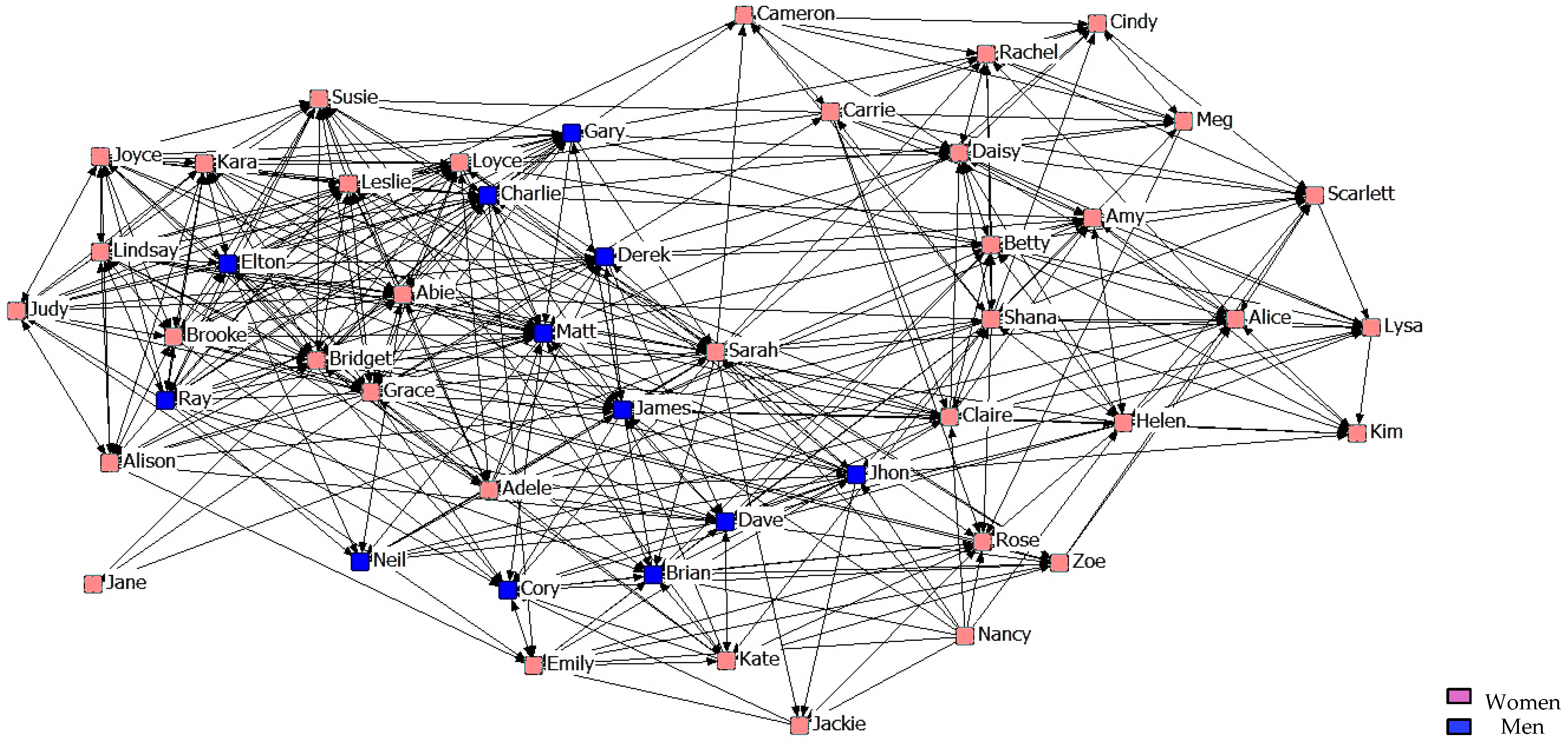
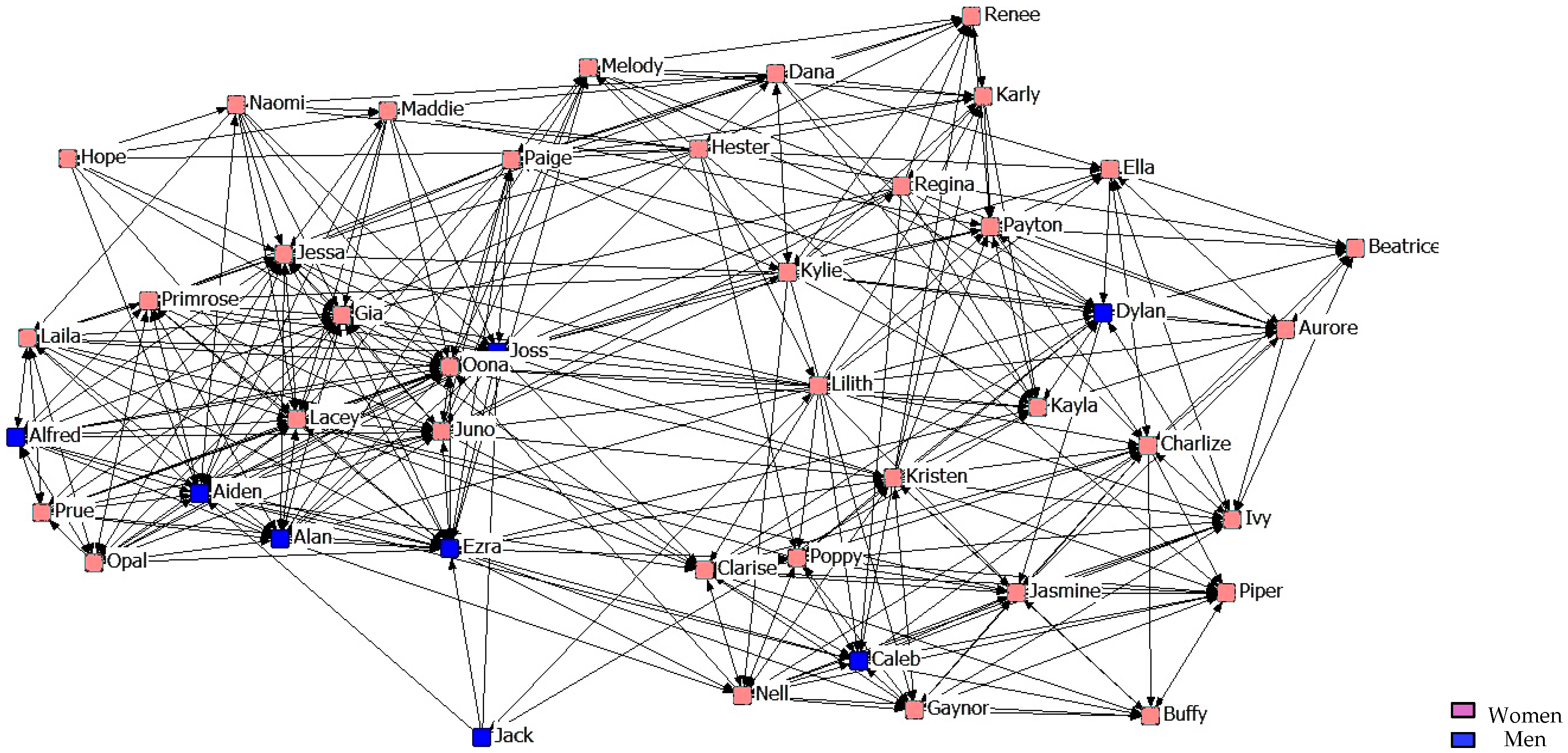
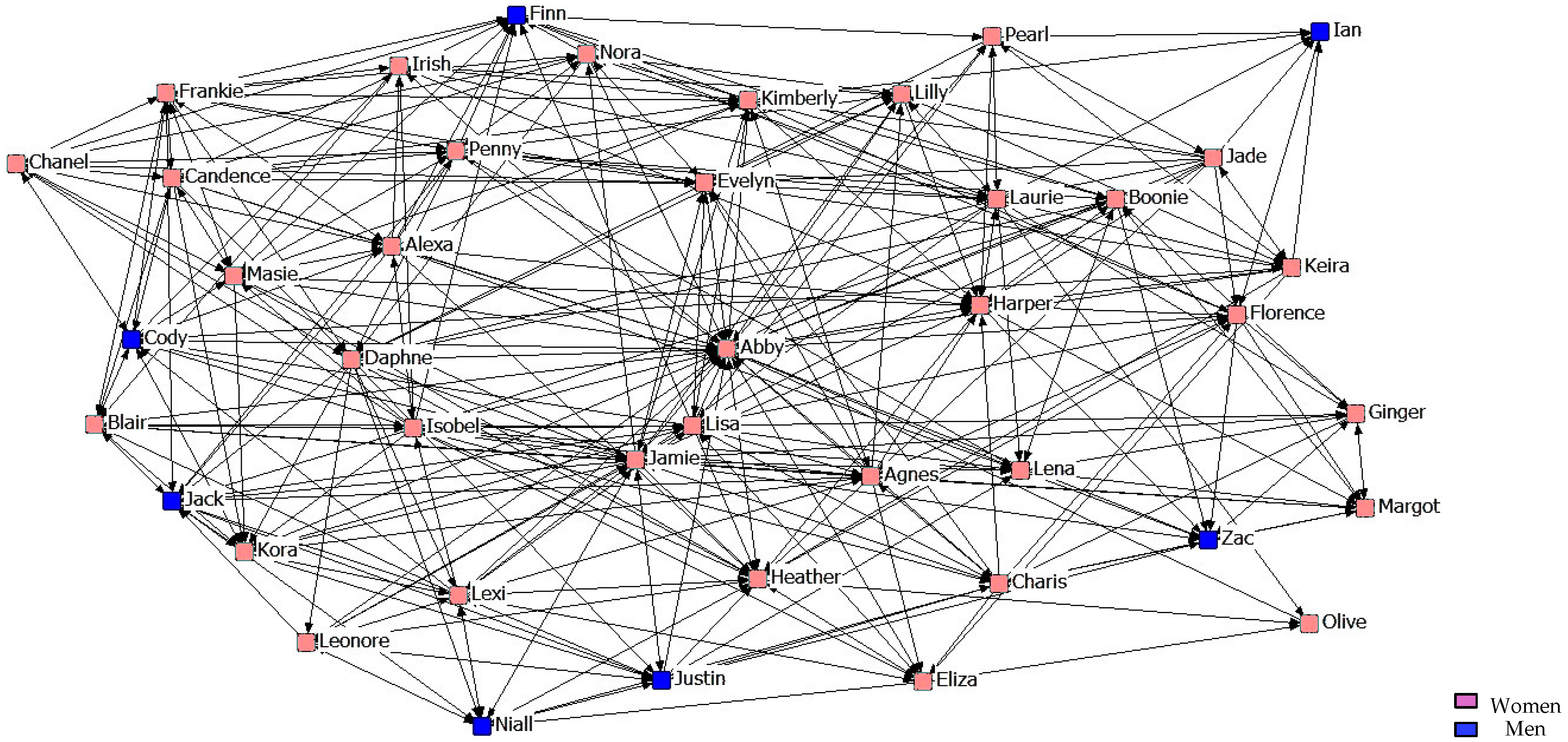
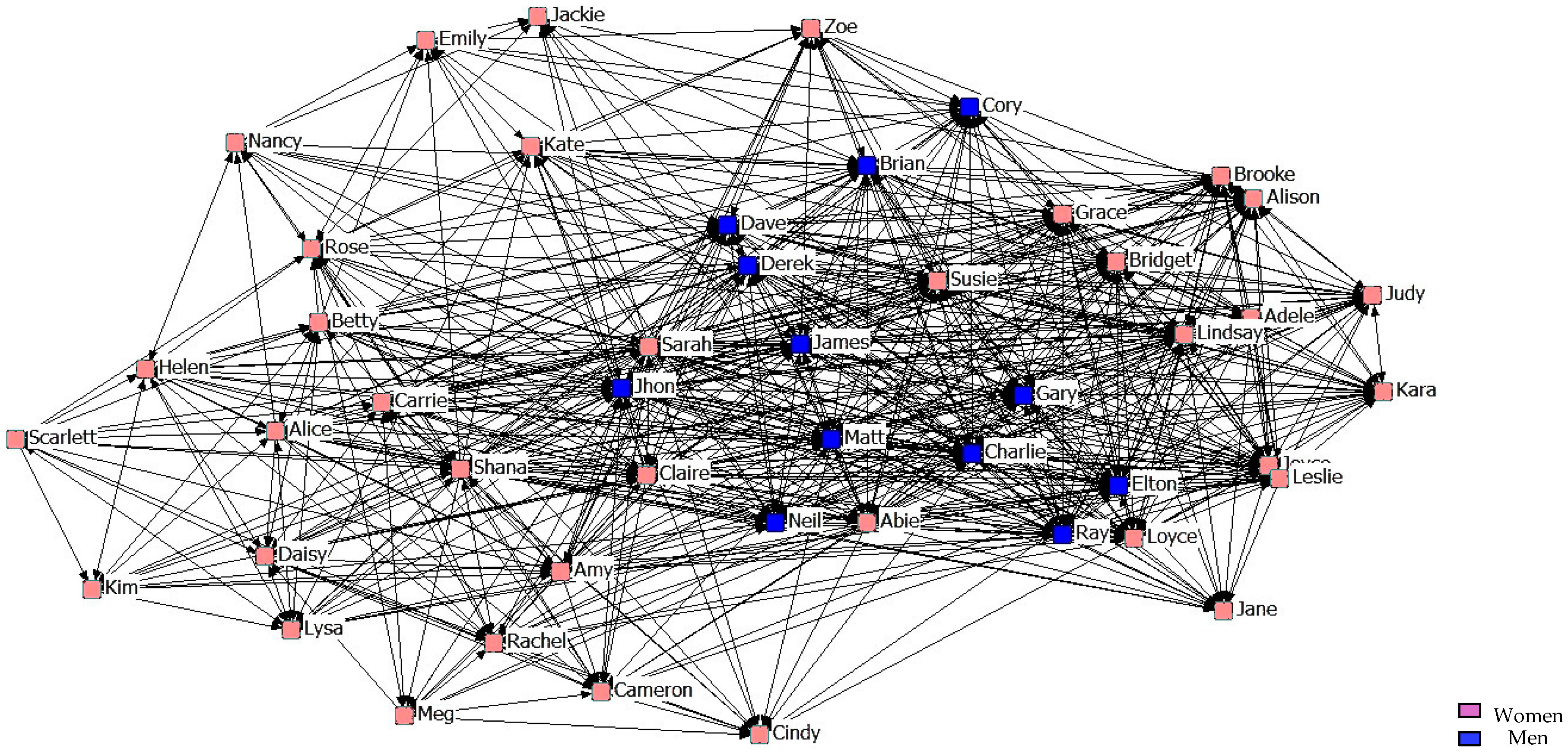
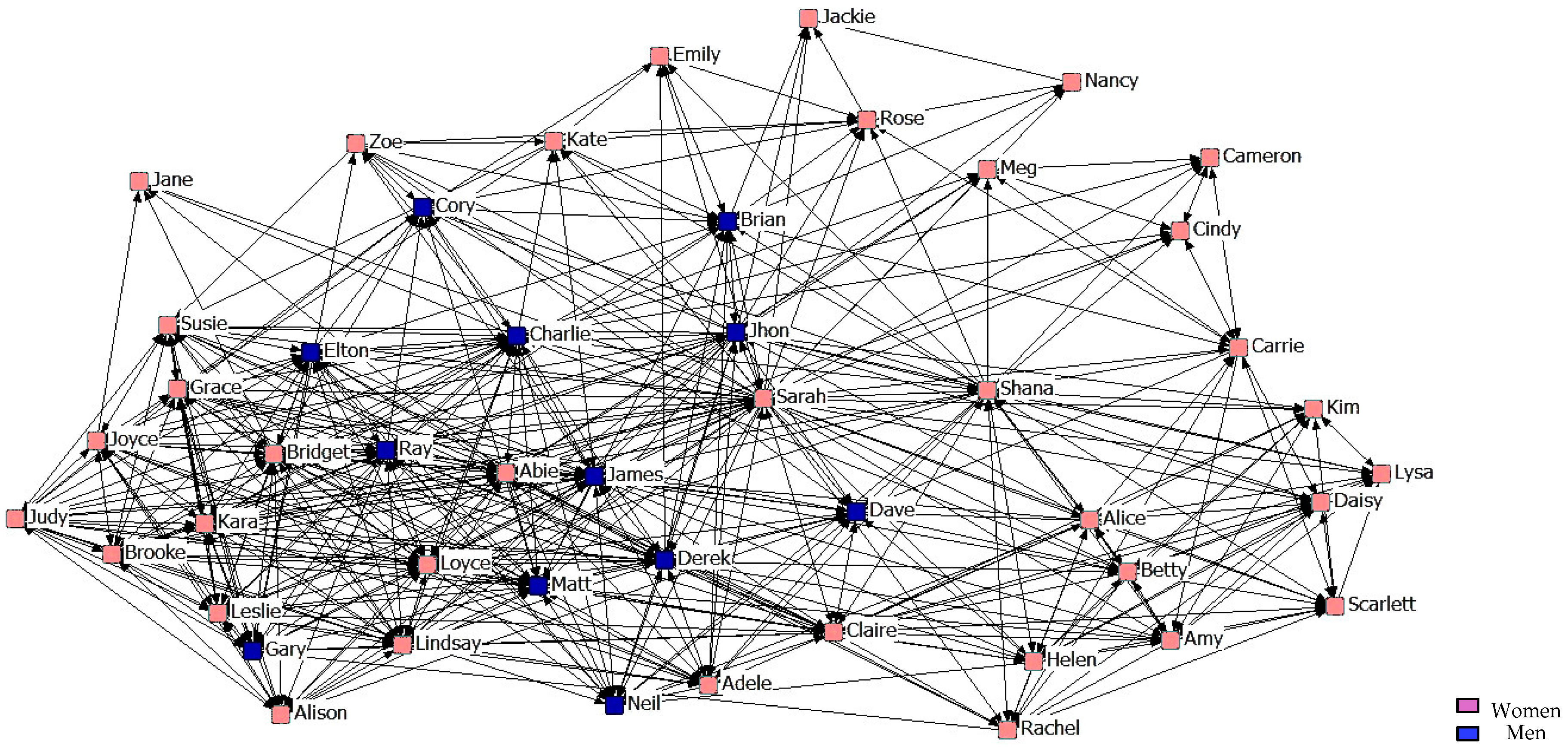
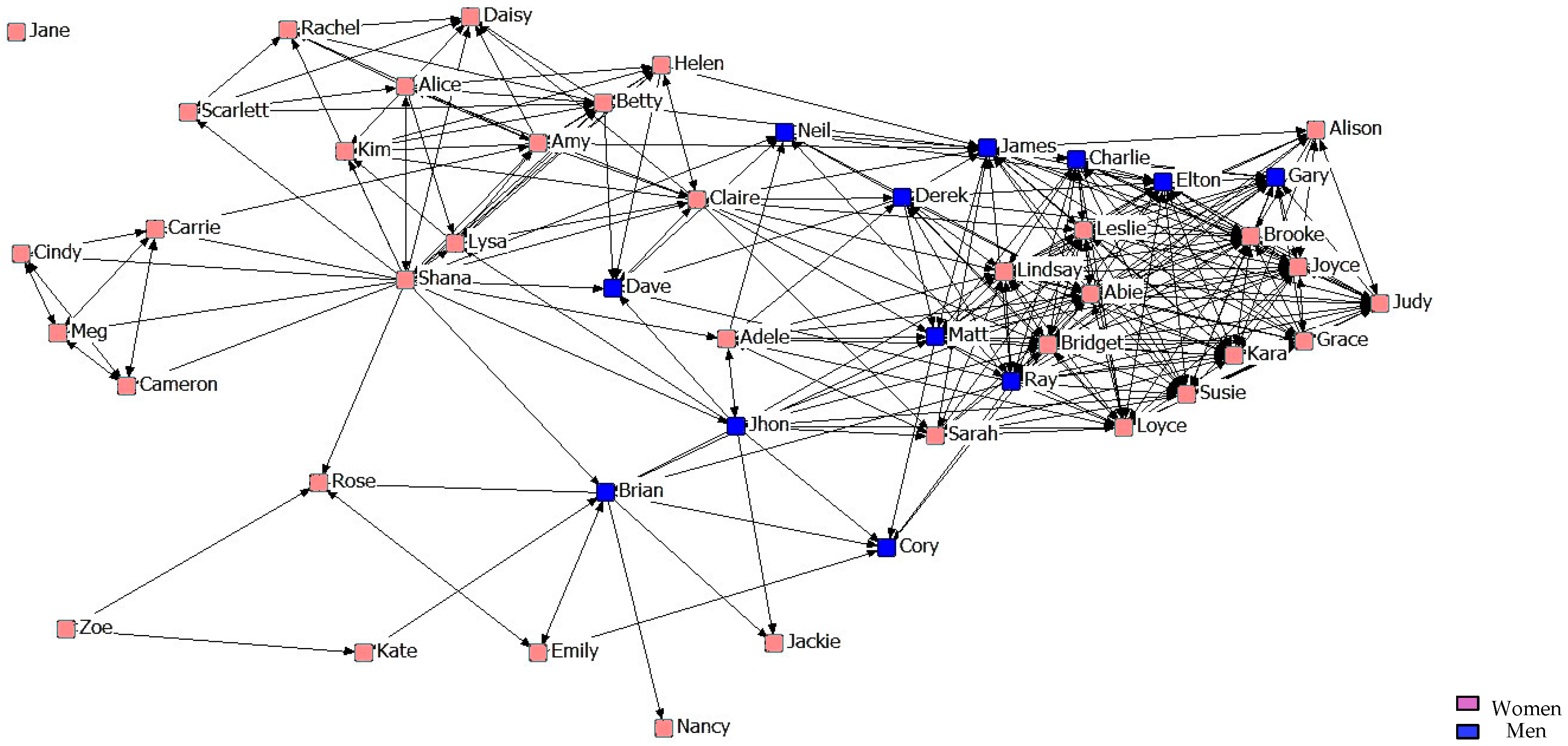



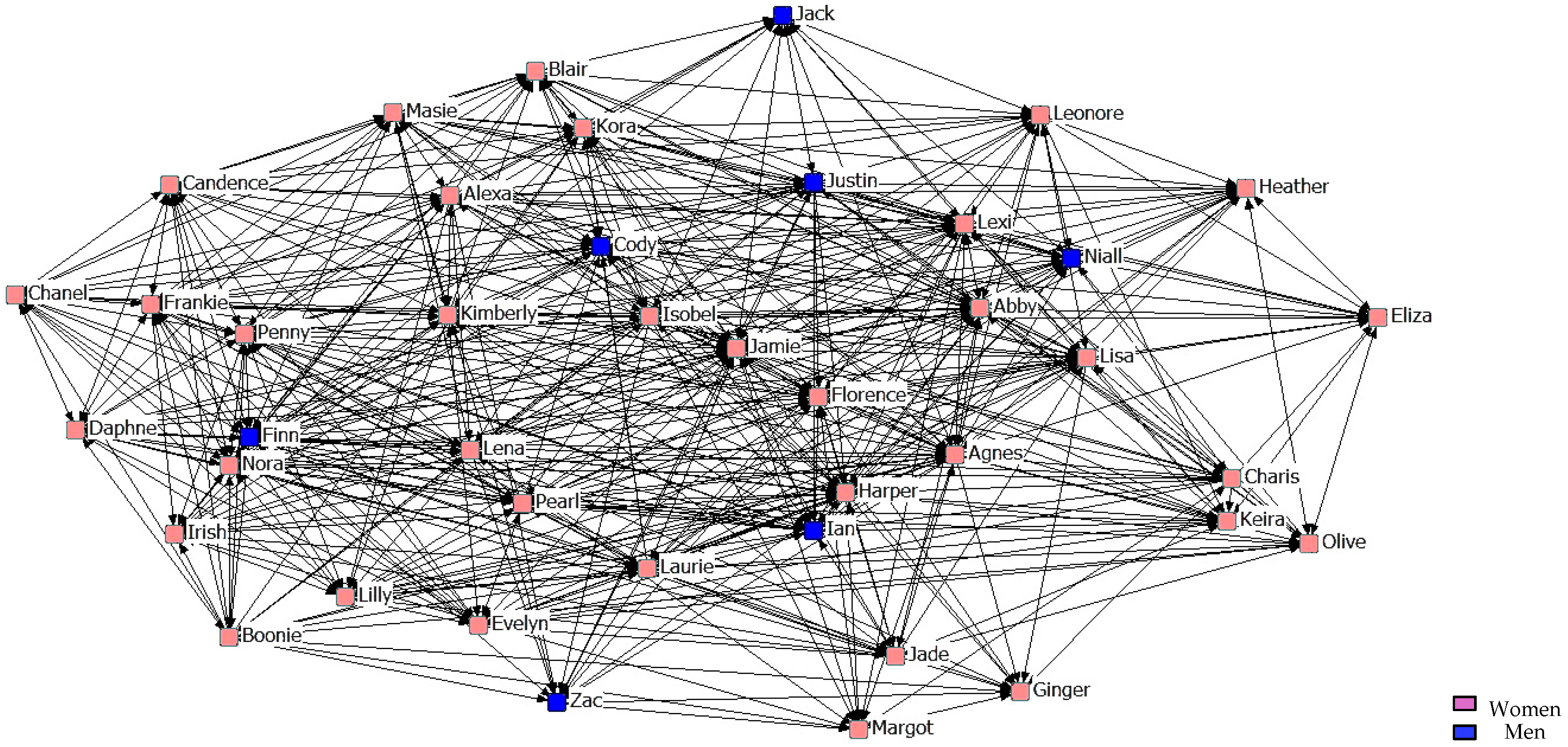
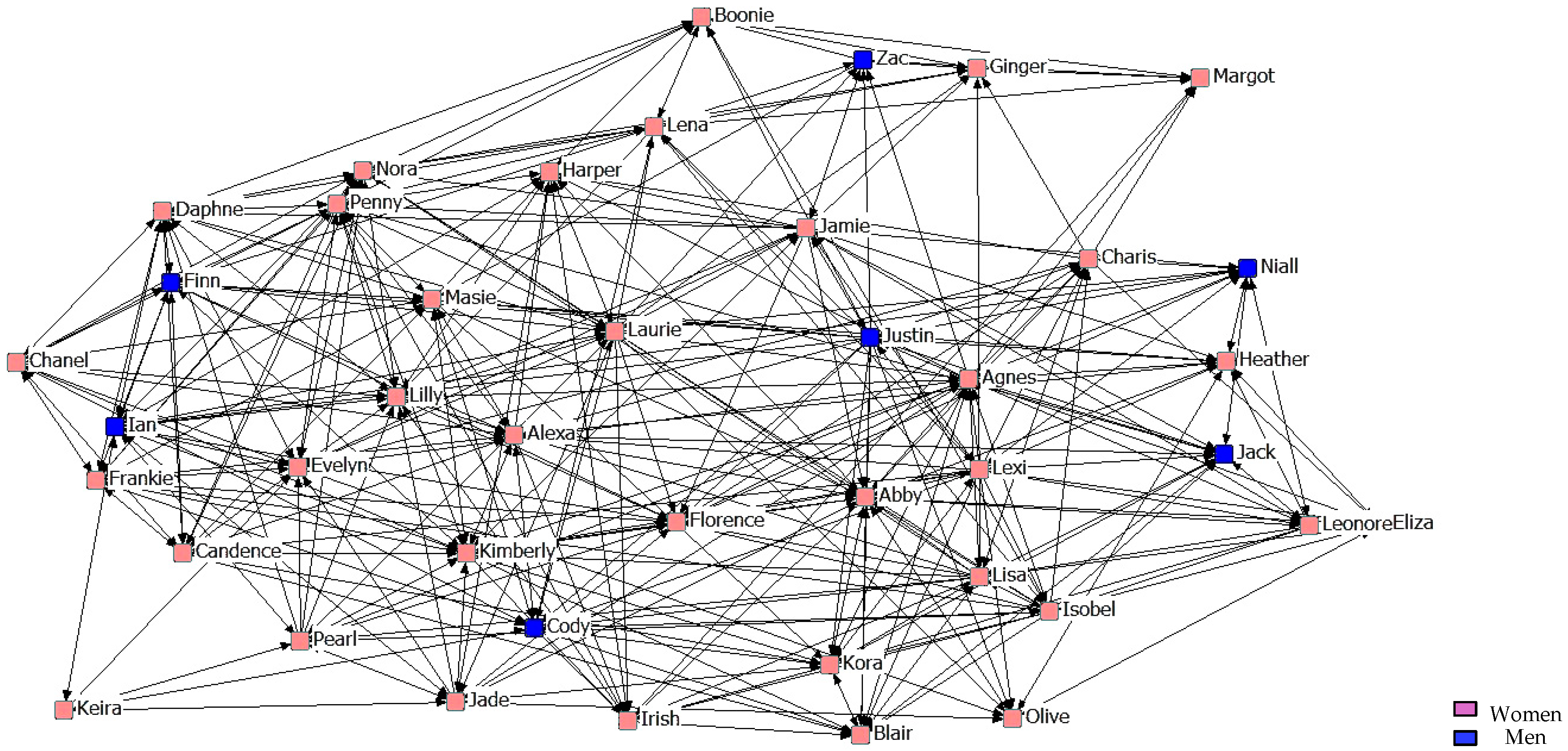
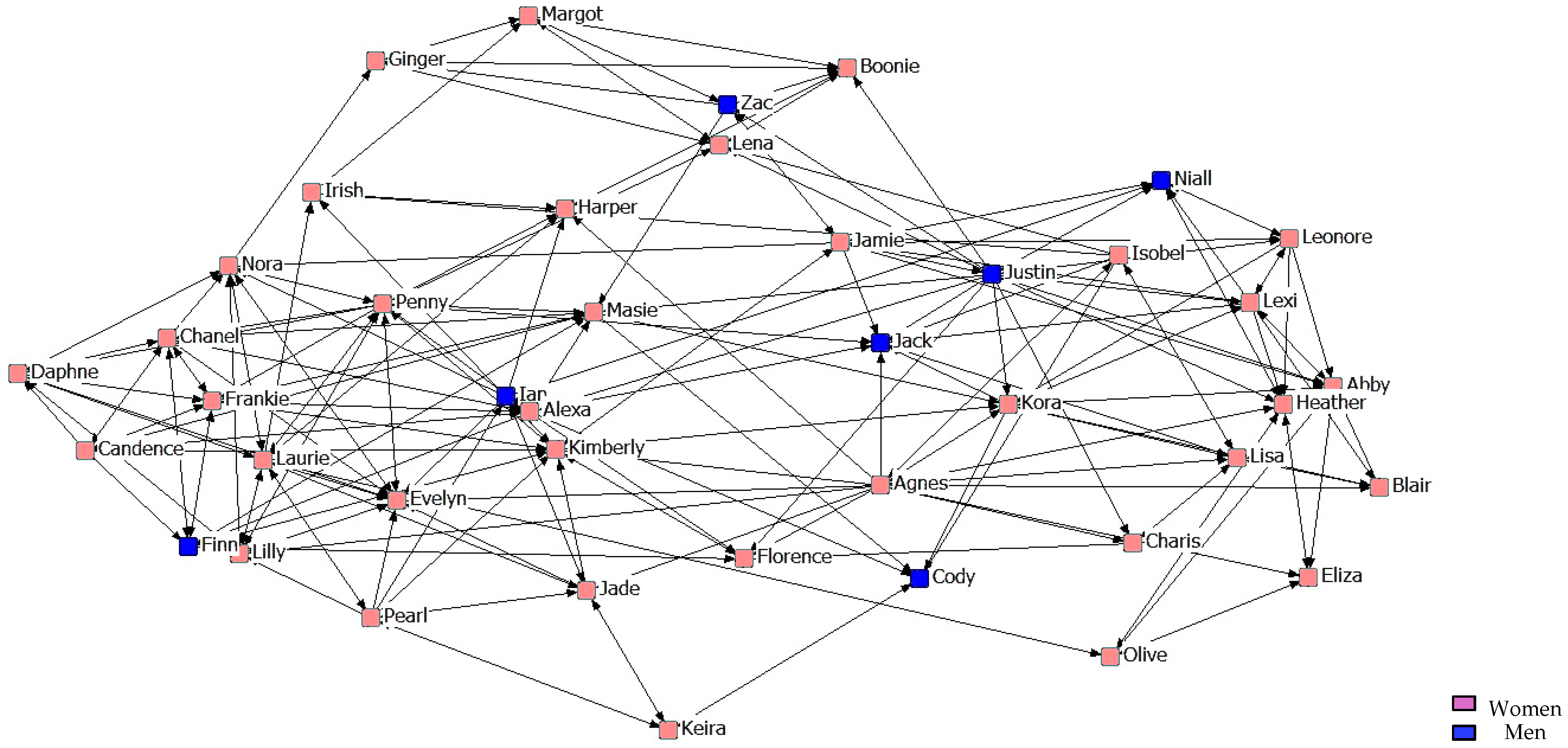
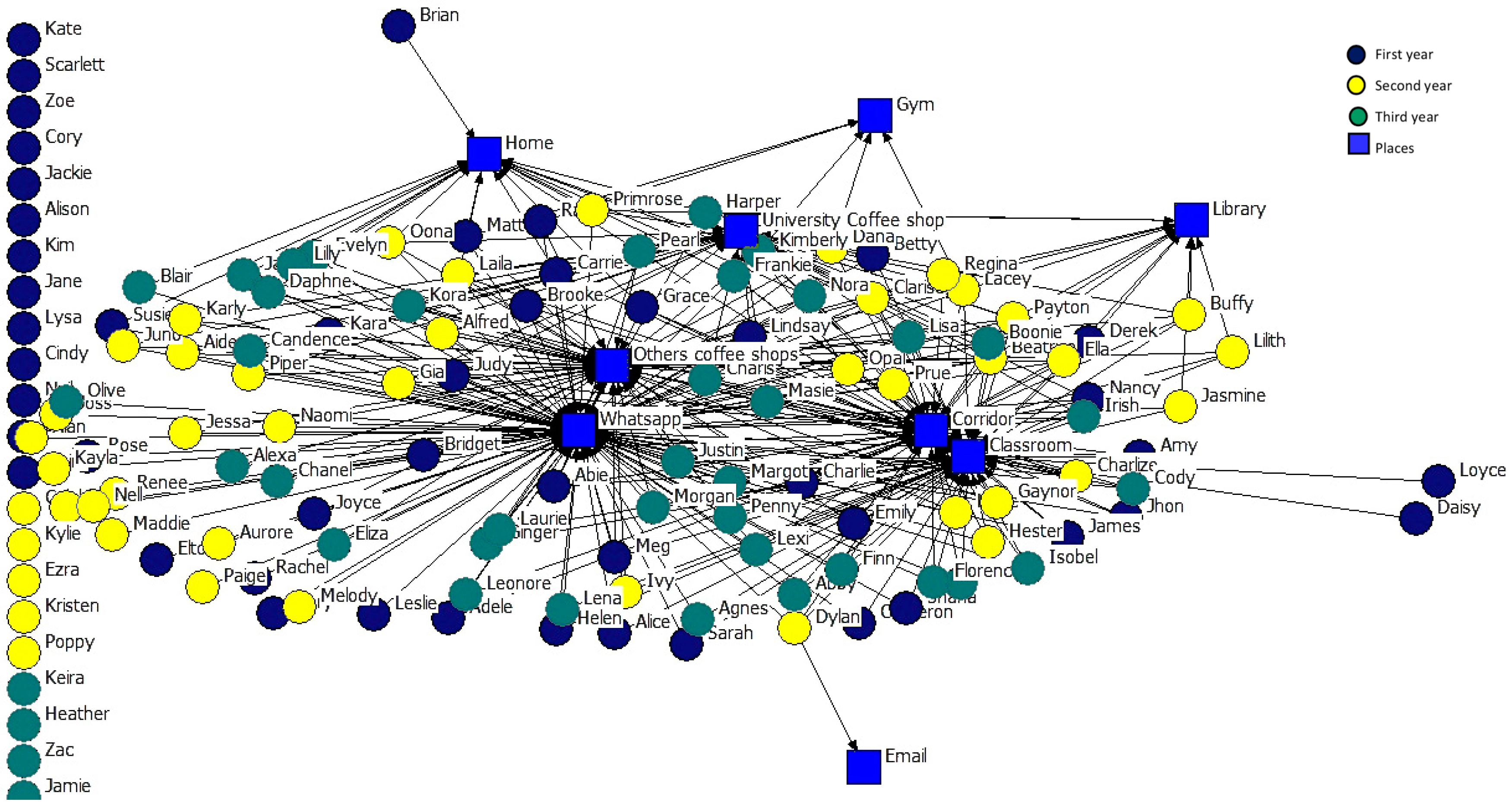
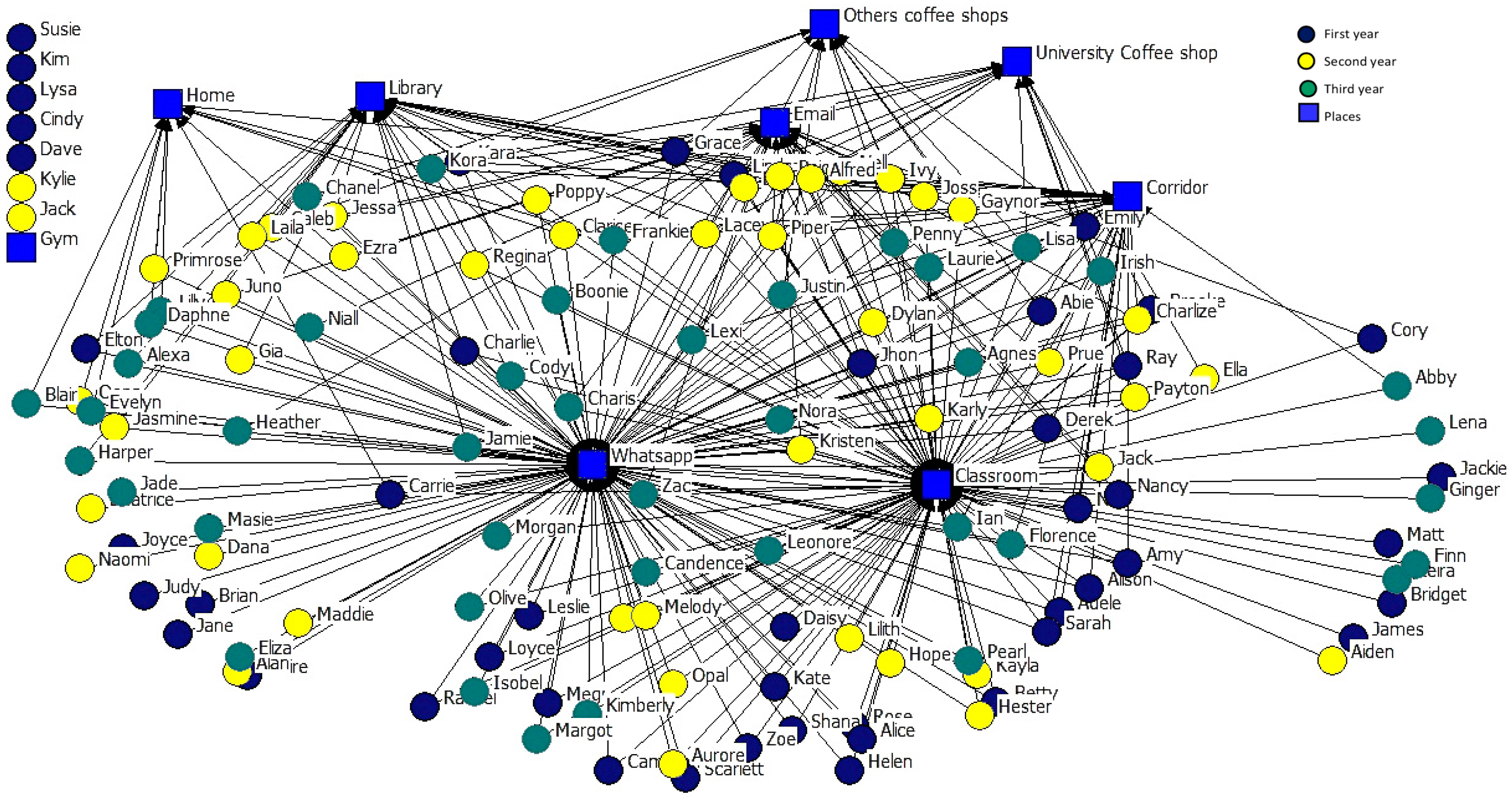
| Study Year | Sex | Total N (%) | |
|---|---|---|---|
| Men N (%) | Women N (%) | ||
| First year | 12 (25%) | 36 (75%) | 48 (100%) |
| Second year | 8 (18%) | 36 (82%) | 44 (100%) |
| Third year | 7 (17%) | 35 (83%) | 42 (100%) |
| Total | 27 | 107 | 134 (100%) |
| Dichotomization: Support Network | First Dichotomization: Minimum Friendship Network | Second Dichotomization: Intermediate Friendship Network | Third Dichotomization: Maximum Friendship Network | ||||
|---|---|---|---|---|---|---|---|
| No presence of support | Presence of support | No presence of friendship | Presence of friendship | No presence of friendship | Presence of friendship | No presence of friendship | Presence of friendship |
| 0, 1 | 2, 3, 4 | 0 | 1, 2, 3, 4 | 0, 1 | 2, 3, 4 | 0, 1, 2 | 3, 4 |
| Variables | N | Mean | Standard Deviation | |
|---|---|---|---|---|
| Engagement—Absorption | First year | 48 | 3.2748 | 1.03296 |
| Second year | 44 | 2.8018 | 1.02480 | |
| Third year | 42 | 2.8362 | 0.99771 | |
| Total | 134 | 2.9820 | 1.03530 | |
| Engagement—Dedication | First year | 48 | 4.8333 | 0.92560 |
| Second year | 44 | 4.7545 | 0.76537 | |
| Third year | 42 | 4.8810 | 0.70684 | |
| Total | 134 | 4.8224 | 0.80549 | |
| Engagement—Vigour | First year | 48 | 3.3956 | 1.08313 |
| Second year | 44 | 2.9170 | 1.16347 | |
| Third year | 42 | 3.0571 | 1.01136 | |
| Total | 134 | 3.1324 | 1.09985 | |
| Resilience | First year | 48 | 29.42 | 5.181 |
| Second year | 44 | 27.57 | 6.241 | |
| Third year | 42 | 28.79 | 5.092 | |
| Total | 134 | 28.61 | 5.539 | |
| Network | Engagement | Centrality V. | Pearson C. |
|---|---|---|---|
| First year. Minimum Friendship Network | Absorption | Outdegree | 0.351 * |
| Degree | 0.308 * | ||
| Closeness | 0.332 * | ||
| Betweenness | 0.403 ** | ||
| First year. Intermediate Friendship Network | Outdegree | 0.318 * | |
| Degree | 0.286 * | ||
| Closeness | 0.291 * | ||
| Betweenness | 0.326 * | ||
| First year. Maximum Friendship Network | Betweenness | 0.308 * | |
| First year. Minimum Friendship Network | Vigour | Betweenness | 0.293 * |
| Second year. Intermediate Friendship Network | Absorption | Eigenvector | −0.346 * |
| Vigour | Eigenvector | −0.303 * | |
| Second year. Maximum Friendship Network | Absorption | Eigenvector | −0.389 ** |
| Dedication | Outdegree | 0.303 * | |
| Vigour | Eigenvector | −0.350 * | |
| Second year. Support Network | Dedication | Degree | 0.315 * |
| Absorption | Eigenvector | −0.299 * | |
| Third year. Minimum Friendship Network | Vigour | Indegree | −0.317 * |
| Third year. Intermediate Friendship Network | Absorption | Indegree | −0.331 * |
| Network | Centrality V. | Pearson C. |
|---|---|---|
| First year. Minimum Friendship Network | Indegree | 0.322 * |
| First year. Intermediate Friendship Network | 0.291 * | |
| Third year. Minimum Friendship Network | Outdegree | 0.346 * |
| Degree | 0.324 * | |
| Eigenvector | 0.350 * | |
| Third year. Intermediate Friendship Network | Outdegree | 0.400 ** |
| Degree | 0.330 * | |
| Closeness | 0.342 * | |
| Eigenvector | 0.325 * | |
| Third year. Maximum Friendship Network | Outdegree | 0.331 * |
| Degree | 0.369 * | |
| Closeness | 0.309 * | |
| Eigenvector | 0.366 * | |
| Betweenness | 0.334 * | |
| Third year. Support Network | Outdegree | 0.312 * |
© 2017 by the authors. Licensee MDPI, Basel, Switzerland. This article is an open access article distributed under the terms and conditions of the Creative Commons Attribution (CC BY) license (http://creativecommons.org/licenses/by/4.0/).
Share and Cite
Fernández-Martínez, E.; Andina-Díaz, E.; Fernández-Peña, R.; García-López, R.; Fulgueiras-Carril, I.; Liébana-Presa, C. Social Networks, Engagement and Resilience in University Students. Int. J. Environ. Res. Public Health 2017, 14, 1488. https://doi.org/10.3390/ijerph14121488
Fernández-Martínez E, Andina-Díaz E, Fernández-Peña R, García-López R, Fulgueiras-Carril I, Liébana-Presa C. Social Networks, Engagement and Resilience in University Students. International Journal of Environmental Research and Public Health. 2017; 14(12):1488. https://doi.org/10.3390/ijerph14121488
Chicago/Turabian StyleFernández-Martínez, Elena, Elena Andina-Díaz, Rosario Fernández-Peña, Rosa García-López, Iván Fulgueiras-Carril, and Cristina Liébana-Presa. 2017. "Social Networks, Engagement and Resilience in University Students" International Journal of Environmental Research and Public Health 14, no. 12: 1488. https://doi.org/10.3390/ijerph14121488








